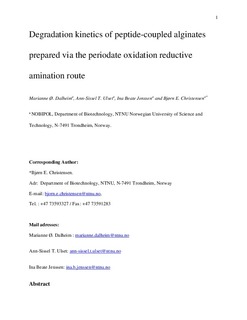| dc.contributor.author | Dalheim, Marianne Øksnes | |
| dc.contributor.author | Ulset, Ann-Sissel Teialeret | |
| dc.contributor.author | Jenssen, Ina Beate | |
| dc.contributor.author | Christensen, Bjørn E. | |
| dc.date.accessioned | 2018-04-12T05:42:27Z | |
| dc.date.available | 2018-04-12T05:42:27Z | |
| dc.date.created | 2017-01-06T15:01:11Z | |
| dc.date.issued | 2017 | |
| dc.identifier.citation | Carbohydrate Polymers. 2017, 157 1844-1852. | nb_NO |
| dc.identifier.issn | 0144-8617 | |
| dc.identifier.uri | http://hdl.handle.net/11250/2493728 | |
| dc.description.abstract | Biomaterials based on peptide-coupled alginates must provide both optimal biological environments and tuneable stability/degradation profiles. The present work investigates the degradation pattern and kinetics of peptide-coupled alginates prepared via the periodate oxidation reductive amination route. Alginates degrade slowly (non-enzymatically) under physiological conditions by acid-catalysed hydrolysis and alkali-catalysed β-elimination, both operating simultaneously but dominated by the latter. While periodate oxidation alone largely increases the rate of β-elimination, substitution restores the susceptibility towards β-elimination to that of the parent alginate. For acid hydrolysis the rate of depolymerization is proportional to the degree of substitution, being approximately one order of magnitude larger than the parent alginate, but still lower than for the corresponding materials with fully reduced dialdehydes. Results also suggest a composition-dependent preference for substitution at C2 or C3. These results demonstrate how the various chemistries introduced by the coupling provide useful means to tune the biodegradability profiles. | nb_NO |
| dc.language.iso | eng | nb_NO |
| dc.publisher | Elsevier | nb_NO |
| dc.rights | Attribution-NonCommercial-NoDerivatives 4.0 Internasjonal | * |
| dc.rights.uri | http://creativecommons.org/licenses/by-nc-nd/4.0/deed.no | * |
| dc.title | Degradation kinetics of peptide-coupled alginates prepared via the periodate oxidation reductive amination route | nb_NO |
| dc.type | Journal article | nb_NO |
| dc.type | Peer reviewed | nb_NO |
| dc.description.version | acceptedVersion | nb_NO |
| dc.source.pagenumber | 1844-1852 | nb_NO |
| dc.source.volume | 157 | nb_NO |
| dc.source.journal | Carbohydrate Polymers | nb_NO |
| dc.identifier.doi | 10.1016/j.carbpol.2016.11.068 | |
| dc.identifier.cristin | 1422510 | |
| dc.relation.project | Norges forskningsråd: 221576 | nb_NO |
| dc.description.localcode | © 2016. This is the authors’ accepted and refereed manuscript to the article. This manuscript version is made available under the CC-BY-NC-ND 4.0 license http://creativecommons.org/licenses/by-nc-nd/4.0/ | nb_NO |
| cristin.unitcode | 194,66,15,0 | |
| cristin.unitname | Institutt for bioteknologi og matvitenskap | |
| cristin.ispublished | true | |
| cristin.fulltext | postprint | |
| cristin.qualitycode | 1 | |

